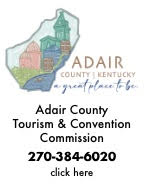| ||||||||||
Dr. Ronald P. Rogers CHIROPRACTOR Support for your body's natural healing capabilities 270-384-5554 Click here for details 


Columbia Gas Dept. GAS LEAK or GAS SMELL Contact Numbers 24 hrs/ 365 days 270-384-2006 or 9-1-1 Call before you dig Visit ColumbiaMagazine's Directory of Churches Addresses, times, phone numbers and more for churches in Adair County Find Great Stuff in ColumbiaMagazine's Classified Ads Antiques, Help Wanted, Autos, Real Estate, Legal Notices, More... 
|
Kentucky Color: Research Results Released Do you suspect that all modern cars look increasingly similar? The researchers at GWSU have proven statistically that the only current choice is among shades of grey. By Billy Joe Fudge Great Wooded South University's Psychology Department has just completed research into a truly disturbing American phenomenon. Because this phenomenon has just been identified, it does not yet have a name. GWSU commissioned this research in response to the question, "what has happened to identifiable uniqueness in America and the American Automobile Industry?" This research was conducted on consumer demand for variety in style and color of the automobile because there is so much historical data to draw upon. This historical data goes back to 1909 when Henry Ford was cranking out Model T's on the world's only moving assembly line. The car only cost $240 and was in high demand and supposedly because black paint dried faster than any other color, Henry Ford said, "you can have any color car you want, as long as it is black"! So, the American people accepted what was available to them. Then as time went on and with multiple car companies around the US and the world developing multiple models and styles in a plethora of colors in an effort to present the consumer with an automobile with identifiable uniqueness, only black became a thing of the past. To get something unique meant there could be an up charge in order to acquire that bit of uniqueness and most American's seemed to be willing to pay for that uniqueness. This quest for uniqueness seems to have peaked during the muscle car era during the late 60's and 70's. Every car manufacturer bragged about the numbers of yellows, greens, blues, reds, golds, browns in their inventory of colors and then, even reached a crescendo with two color or as they were called, two-tone autos rolling off the assembly lines in record numbers. Since then however, the variety of models and colors offered to car buyers has steadily diminished to this very day. Now, because of federal fuel efficiency guidelines, which require less heavy and more streamlined, aerodynamic models, most vehicle manufacturer's models are distinguishable only by the company logo. This is "strike one" against being able to purchase an automobile with identifiable uniqueness. This is where the GWSU's research has come into play. Our research has identified "strike two". After two years of performing color analysis from aerial and satellite photographs of automobile dealer lots, public and private parking lots and even counts of colors of vehicles traveling on country roads to interstates, the data is disturbing. According to our research 91% of 10 year old and younger vehicles on the road are either white, black or nuances of gray. Another 6% are red or a nuance of red. This leaves only 3% of vehicles on the road that might fall into the yellow, green, blue, gold, brown, etc. or nuances of these brighter colors. We Americans have certainly lost our way when it comes to identifiable uniqueness. The question is why? Why have we lost our way into a world of, no color? Why have we become complacent when it comes to color? Why have we settled for the mundane? White and Black are technically not even colors in that a color is produced by a particular wavelength of light. White contains all wavelengths of light, black has no wavelengths of light and since gray is produced by mixing black and white it is also not a color, so to speak. What is next? Are we soon to be yawning at a rainbow? Will we be found dozing at a beautiful sunset? Will we be happy with broom sedge bouquets rather than bold reds soft yellows and passionate pink arrangements? Much more research to be done by the GWSU Psychology Department. What is next and what does it mean for the human condition. Is there a "strike three" when it comes to identifiable uniqueness? Maybe, maybe not but never fear, Great Wooded South University will continue to lead the nation with this important work! This story was posted on 2019-06-08 09:19:48
Printable: this page is now automatically formatted for printing.
Have comments or corrections for this story? Use our contact form and let us know.
More articles from topic Kentucky Color by Billy Joe Fudge:
Kentucky Color - Destination Sunset Kentucky Color: Lesson in Physics Beauty, peace and harmony in nature Kentucky Color: As It Should Be Kentucky Color: Winter Beauty III Kentucky Color: Visit for a Spell Kentucky Color: I JUST ASK THAT YOU REMEMBER Remembering Ed Waggener: Kentucky Color Billy Joe Fudge: When Doc Grant pole vaulted without a pole Kentucky Color - GWSU Research Project: Fogs-in-August View even more articles in topic Kentucky Color by Billy Joe Fudge |



|
||||||||
|
| ||||||||||
|
Quick Links to Popular Features
Looking for a story or picture? Try our Photo Archive or our Stories Archive for all the information that's appeared on ColumbiaMagazine.com. | ||||||||||
|
Contact us: Columbia Magazine and columbiamagazine.com are published by Linda Waggener and Pen Waggener, PO Box 906, Columbia, KY 42728. Please use our contact page, or send questions about technical issues with this site to webmaster@columbiamagazine.com. All logos and trademarks used on this site are property of their respective owners. All comments remain the property and responsibility of their posters, all articles and photos remain the property of their creators, and all the rest is copyright 1995-Present by Columbia Magazine. Privacy policy: use of this site requires no sharing of information. Voluntarily shared information may be published and made available to the public on this site and/or stored electronically. Anonymous submissions will be subject to additional verification. Cookies are not required to use our site. However, if you have cookies enabled in your web browser, some of our advertisers may use cookies for interest-based advertising across multiple domains. For more information about third-party advertising, visit the NAI web privacy site.
| ||||||||||

















































